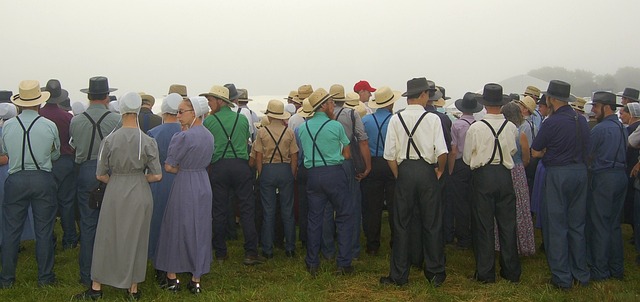The Amish typically use outhouses or privies as their primary form of toilet facilities.
Table of Contents
Traditional Amish Toilet Practices
Have you ever wondered what the Amish use for toilets? Well, you’re not alone! The Amish are known for their traditional way of life, which includes living without many modern conveniences. When it comes to toilets, the Amish have their own unique practices that have been passed down through generations.
In traditional Amish communities, indoor plumbing is not common. Instead, the Amish rely on outhouses or privies for their bathroom needs. These structures are typically located a short distance away from the main house and are shared by multiple families in the community. Outhouses are simple, small buildings that provide a private space for individuals to use the bathroom.
Inside the outhouse, you won’t find a modern flush toilet like you might be used to. Instead, the Amish use what is known as a “privy seat.” This is a simple wooden seat with a hole in the middle, which is placed over a hole in the ground. When nature calls, individuals sit on the privy seat and do their business directly into the hole.
To ensure cleanliness and hygiene, the Amish often sprinkle lime or sawdust into the hole after each use. This helps to control odors and break down waste. Additionally, some Amish communities have designated individuals who are responsible for regularly emptying and maintaining the outhouses.
While this may seem like a primitive way of doing things, the Amish have their reasons for sticking to these traditional practices. For one, they believe in living a simple and humble life, free from the distractions and excesses of modern society. Using outhouses and privy seats aligns with their values of simplicity and self-sufficiency.
Another reason the Amish continue to use traditional toilets is their commitment to sustainability. By using outhouses, they avoid wasting water that would be used in flushing toilets. This helps to conserve natural resources and reduce their environmental impact. Additionally, the waste from the outhouses can be used as fertilizer for crops, further promoting sustainability and self-sufficiency.
It’s important to note that not all Amish communities adhere strictly to these traditional toilet practices. Some may have adopted modern conveniences like indoor plumbing, especially in areas where local regulations require it. However, many Amish communities still choose to maintain their traditional way of life, including their unique toilet practices.
So, the next time you find yourself wondering what the Amish use for toilets, remember that they rely on outhouses and privy seats. These simple and sustainable practices are a reflection of their commitment to living a humble and self-sufficient life. While it may be different from what you’re used to, it’s important to respect and appreciate the diversity of cultural practices that exist in our world.
Modern Alternatives to Amish Toilets

Have you ever wondered what the Amish use for toilets? It’s a question that many people have, especially those who are curious about the Amish way of life. The Amish are known for their simple and traditional lifestyle, and this extends to their bathroom habits as well. While they may not have the modern conveniences that most of us take for granted, the Amish have found alternative ways to meet their bathroom needs.
One modern alternative to traditional toilets that the Amish use is the composting toilet. Composting toilets are a sustainable and eco-friendly option that doesn’t require any water or plumbing. Instead, waste is collected in a container and mixed with organic material like sawdust or peat moss. Over time, the waste breaks down into compost that can be used as fertilizer for gardens or crops. Composting toilets are a popular choice among the Amish because they align with their values of simplicity and sustainability.
Another alternative that the Amish use is the incinerating toilet. Incinerating toilets work by heating waste to a high temperature, reducing it to ash. This eliminates the need for water or plumbing, making it a practical option for those living off the grid. Incinerating toilets are also odorless and require minimal maintenance, making them a convenient choice for the Amish.
For those who prefer a more traditional option, the outhouse is still a common sight in Amish communities. Outhouses are simple structures that are separate from the main house and provide a private space for bathroom needs. They are typically equipped with a hole in the ground or a pit that waste falls into. Outhouses require regular maintenance, as the pit needs to be emptied periodically. However, they are a cost-effective and low-maintenance option that many Amish families continue to use.
In recent years, some Amish communities have also started using portable toilets. Portable toilets are self-contained units that can be easily moved and require minimal installation. They are equipped with a waste tank that needs to be emptied regularly. Portable toilets are a convenient option for Amish families who may need to move frequently or who prefer a more modern solution.
While the Amish may not have the same bathroom amenities as most of us, they have found practical and sustainable alternatives that suit their way of life. Whether it’s composting toilets, incinerating toilets, outhouses, or portable toilets, the Amish have adapted to their unique circumstances and made the best of what they have. These alternatives not only meet their bathroom needs but also align with their values of simplicity, sustainability, and self-sufficiency.
So, the next time you find yourself wondering what the Amish use for toilets, remember that they have found creative and practical solutions that work for them. From composting toilets to outhouses, the Amish have embraced alternative options that allow them to live in harmony with their environment and maintain their traditional way of life.
Environmental Impact of Amish Toilet Systems
Have you ever wondered what the Amish use for toilets? It’s a question that many people have, especially considering the Amish’s commitment to living a simple and traditional lifestyle. In this article, we will explore the environmental impact of Amish toilet systems and shed some light on what they use for their bathroom needs.
When it comes to the Amish, their way of life is deeply rooted in their religious beliefs and traditions. They strive to live a life that is in harmony with nature and the environment. This commitment extends to all aspects of their daily lives, including their toilet systems.
Unlike modern society, the Amish do not rely on flush toilets connected to a centralized sewage system. Instead, they use what is commonly known as an outhouse or an outdoor privy. These structures are typically small, simple, and located a short distance away from their homes.
The use of outhouses by the Amish has several environmental benefits. Firstly, it eliminates the need for a complex sewage system, which requires a significant amount of resources and energy to build and maintain. By using outhouses, the Amish reduce their carbon footprint and minimize their impact on the environment.
Additionally, the waste produced in outhouses is often used as fertilizer for their crops. This practice, known as “humanure,” involves composting the waste to create nutrient-rich soil. By recycling their waste in this way, the Amish are able to minimize their reliance on chemical fertilizers and promote sustainable agriculture.
Furthermore, the use of outhouses by the Amish helps to conserve water. Flush toilets in modern homes consume a significant amount of water with each use. In contrast, outhouses require little to no water, making them a more environmentally friendly option. This water conservation not only benefits the environment but also helps the Amish to live in accordance with their values of simplicity and frugality.
It is important to note that while the Amish primarily use outhouses, some communities have adopted alternative toilet systems that are more in line with their traditional way of life. One such system is the composting toilet. Composting toilets are designed to break down waste through natural processes, such as decomposition and evaporation. This allows the waste to be safely and effectively converted into compost.
Composting toilets offer several advantages over traditional flush toilets. They require little to no water, reduce the need for chemical cleaners, and produce valuable compost that can be used to enrich the soil. These benefits align perfectly with the Amish’s commitment to sustainable living and environmental stewardship.
In conclusion, the Amish’s commitment to living a simple and traditional lifestyle extends to their toilet systems. By using outhouses or composting toilets, they are able to minimize their environmental impact and live in harmony with nature. These toilet systems not only reduce the need for complex sewage systems and conserve water but also promote sustainable agriculture through the recycling of waste. So, the next time you wonder what the Amish use for toilets, remember that their choice is not only rooted in tradition but also in their deep respect for the environment.
Cultural Significance of Amish Toilet Practices
Have you ever wondered what the Amish use for toilets? It’s a question that may not have crossed your mind before, but it’s an interesting one nonetheless. The Amish, known for their simple and traditional way of life, have unique practices when it comes to something as basic as using the bathroom. In this article, we will explore the cultural significance of Amish toilet practices and shed some light on what they use for toilets.
To understand the Amish toilet practices, it’s important to first understand their way of life. The Amish are a religious group that values simplicity, humility, and community. They live in close-knit communities and adhere to a set of strict religious principles. These principles guide every aspect of their lives, including their toilet practices.
Unlike most modern households, the Amish do not have indoor plumbing. This means that they do not have the luxury of flushing toilets or running water in their homes. Instead, they rely on outhouses or privies for their bathroom needs. These structures are located outside of their homes and are typically simple wooden buildings with a hole in the ground.
The use of outhouses serves a practical purpose for the Amish. Without access to indoor plumbing, they need a designated space to relieve themselves. Outhouses provide a sanitary and private solution to this basic human need. They are typically well-maintained and cleaned regularly to ensure hygiene.
But the cultural significance of Amish toilet practices goes beyond practicality. For the Amish, the use of outhouses is a way to maintain their separation from the modern world. By eschewing modern conveniences like indoor plumbing, they are able to preserve their traditional way of life and remain connected to their religious beliefs.
In addition to using outhouses, the Amish also have specific rules and customs surrounding toilet practices. For example, they believe in modesty and privacy, even when using the bathroom. This means that they do not have doors on their outhouses, as they believe that God is always watching and that privacy is unnecessary.
Furthermore, the Amish do not use toilet paper. Instead, they use corn cobs or pieces of cloth to clean themselves after using the bathroom. This practice may seem unusual to outsiders, but it is deeply rooted in their religious beliefs. The Amish believe in simplicity and avoiding excess, and using reusable materials for personal hygiene aligns with these principles.
It’s important to note that not all Amish communities have the same toilet practices. There may be variations depending on the specific community and its interpretation of religious principles. However, the use of outhouses and the avoidance of modern plumbing are common threads that run through most Amish communities.
In conclusion, the Amish have unique toilet practices that are deeply rooted in their religious beliefs and way of life. The use of outhouses and the avoidance of modern plumbing are practical solutions to their bathroom needs, but they also serve a larger cultural purpose. By maintaining their separation from the modern world and adhering to their religious principles, the Amish are able to preserve their traditional way of life. So, the next time you find yourself wondering what the Amish use for toilets, remember that their practices are not just about practicality, but also about cultural significance.
Conclusion
In conclusion, the Amish typically use outhouses or privies as their primary form of toilets.
For licensing reasons, we must provide the following notice: This content was created in part with the help of an AI.


